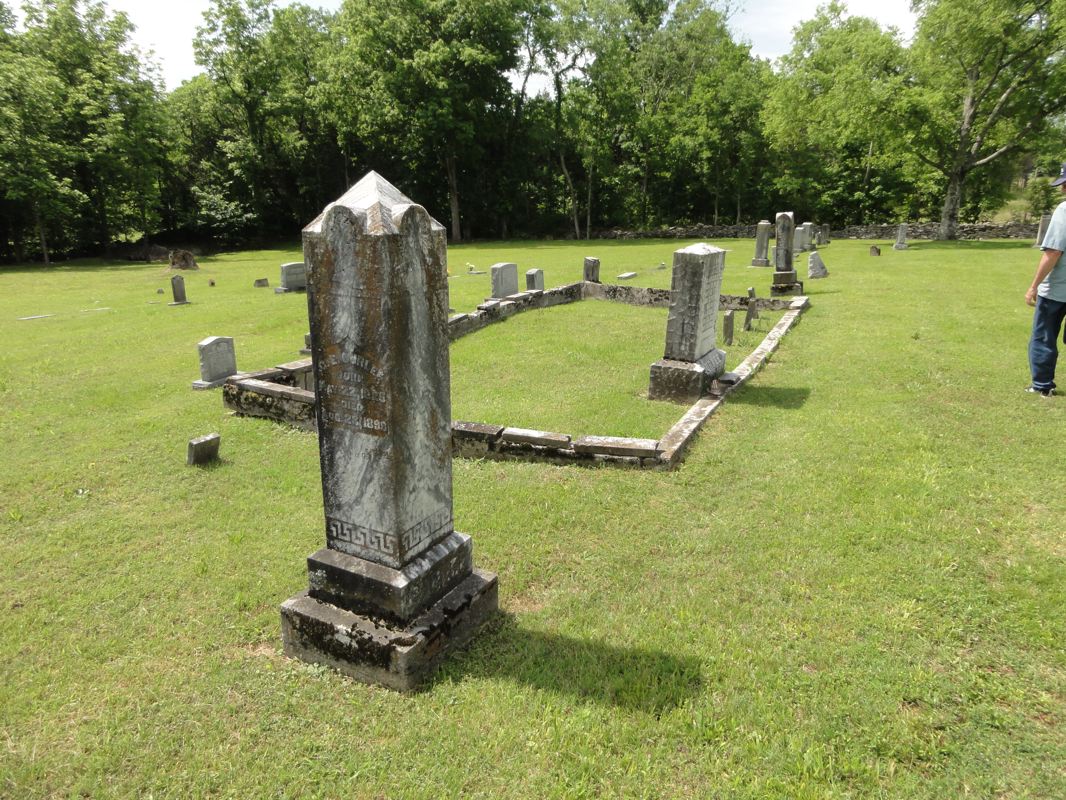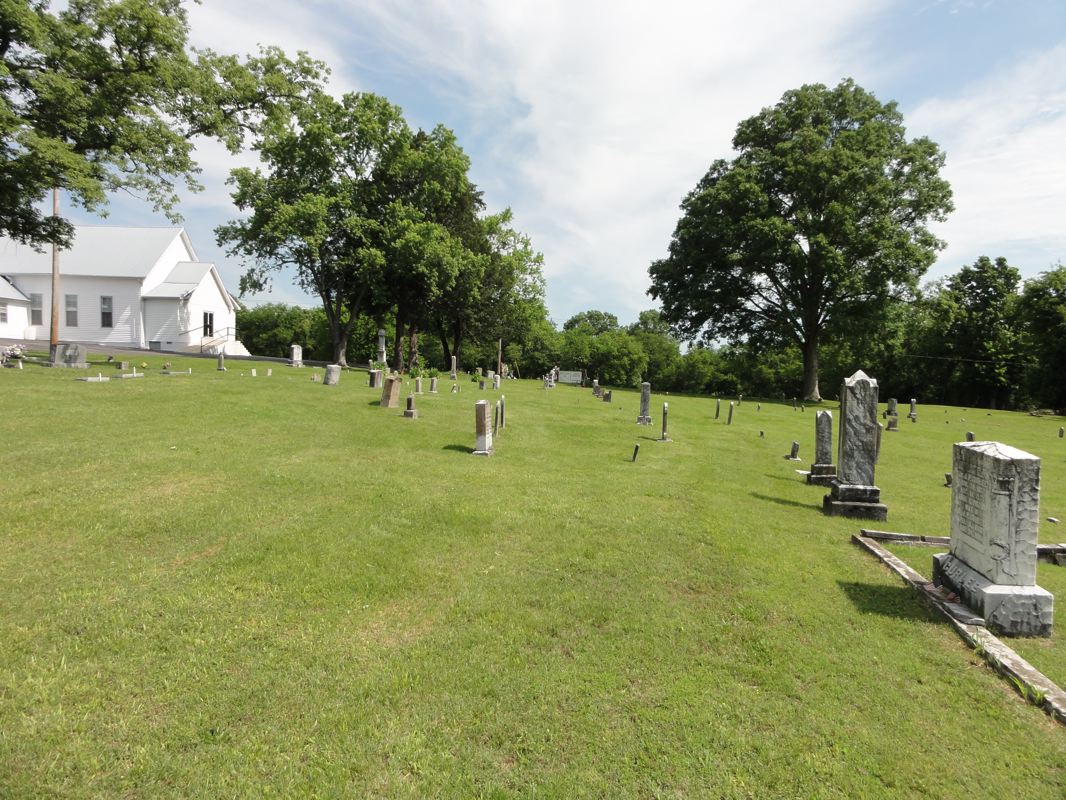The Curlee Family
Three Generations Of Preaching The Ancient Gospel
1791-1851
![]()
The Life Of Calvin Curlee
The subject of this sketch was one of those heroes of the gospel who during the early days of the Restoration Movement did much for the cause of primitive Christianity. He has been forgotten by many who are now enjoying the blessings of his labors. Very little has been written about him and he left very little on record.
Calvin Curlee was born in North Carolina in 1791. He moved with his parents to Middle Tennessee and settled in what is now Cannon County. In 1820 he was living in Cannon County, near Woodbury, the county seat. He married Rebecca Fortenberry, who was born in South Carolina. He reared a large family, and many of his descendants are now living in Cannon County.
He was reared in the Baptist faith and began preaching for the Baptists, and he continued to preach as a Baptist preacher for fifteen years. When Alexander Campbell came to Nashville, Tenn., to preach, Calvin Curlee came to hear him. He remained several days in Nashville and heard every discourse preached by Mr. Campbell. After returning home he was so disturbed by what he had heard Mr. Campbell preach that he could scarcely eat or sleep for some days. He walked the floor and pondered the Scriptural truths which he had heard, and then he would sit down and read his Bible to justify his conclusion. He continued this for several days, and finally while walking the floor he paused and remarked to his wife: "Becky, somebody is wrong, and I think that we are." He would not accept the new-found truths until he had fully justified them by the Bible; but when he learned that he was in error, he did not hesitate to give up the error and embrace the truth. He soon began to preach and teach the simple gospel as it is revealed in the New Testament. Of course he incurred the enmity of his Baptist friends; however, he retained their respect, for they all knew him to be an honest man and upright in his life. Many who were his enemies at first later saw the truth and praised him for leading them into a fuller knowledge of the gospel.
He was a very close friend of Tolbert Fanning. They labored much together. Mr. Fanning esteemed him very highly for his native ability and for his zeal in the cause of Christ. They had much in common, as both believed the Bible to be the word of God and the only authority in religious affairs. Again, both of them were very fond of fine horses and took great interest in raising and training them. Curlee was a hard worker and accumulated some wealth. The records of Cannon County show that he was a taxpayer of that county and that his property was assessed at three thousand dollars in 1850. This was a large sum for that day. His property consisted of land and live stock.
He labored in Cannon County and adjoining counties and established many congregations. He gave five acres of land for a church house and cemetery. The church was established there through his labors. It is known today as Curlee's Church. A strong congregation meets there now, and a grandson, Dr. J. P. Curlee, preaches for the church there frequently.
When Tolbert Fanning started the publication of the Christian Review in 1844, Calvin Curlee helped him in getting up the first subscription list. In the February issue of the Christian Review (the second issue of that paper), Calvin Curlee wrote as follows to Mr. Fanning: "I have had the good company of Brother L. N. Murphree some two weeks. We visited the brethren at Philadelphia, Warren County, Tenn.; immersed seven, and one was added from the Baptists. I am going to ride this year as an evangelist in Bedford, Franklin, and Warren Counties." (Christian Review, 1844, page 47.)
Again, we find the following from his pen, written from Cannon County, September 2, 1844:
"For the encouragement of your readers I write to let you know that we have just closed a meeting at my house, the result of which was as follows: Thirty-one persons were immersed, three of whom were from the old Presbyterians, four from the Cumberlands, one from the Methodists, and four from the Baptists. One Methodist lady united who had been immersed. One of our brethren who had been out of the way came back, made a noble confession, and was received. There were many persons in attendance. During the whole of our meeting, to their credit be it told, they honored the Author of the Bible and themselves by hearing what was spoken."
Brethren R. B. Hall, S. E. Jones, Y. W. McDaniel, B. White, and William Dill labored with us. The gospel is rapidly obtaining in my neighborhood. We have persons from all the sects to hear us and much prejudice is put to rest. On my last circuit, at Flat Creek, Bedford County, Tenn., we immersed eight, and two at Bean's Creek. In all, we added fourteen. (Christian Review, 1844, page 164.)
In the history of the "Churches of Christ" by John T. Brown we find Calvin Curlee mentioned among the early preachers of Middle Tennessee. He is mentioned together with Jesse L. Sewell, Isaac Sewell, T. Fanning, Sandy E. Jones, J. J. Trott, W. C. Huffman, and Jesse B. Furguson. There are now twenty-two congregations in Cannon County, more than that number in Rutherford County, and a good number in Warren, DeKalb, and Bedford counties, which, either directly or indirectly, are the result of the good seed sown by Calvin Curlee. He was not known very extensively, as he confined his labors to Middle Tennessee. He was a modest man and cared nothing about publicity. He lived and labored before there were many papers published, hence there is but little to be found concerning his work.
In the Millennial Harbinger
of 1852, on page 119, we have a brief obituary of Calvin Curlee, which
is given in full here:
"Departed this life, on October 23, 1851, in the
triumphant hope of the gospel, Elder Calvin Curlee, aged sixty years.
Some thirty years since the deceased became a member of the Baptist
Church, shortly after which he began to preach; and after continuing in
that communion some fifteen years, he united with the Christian Church,
and until within a few days of his death continued a most zealous
laborer in the good cause of truth, winning many souls to Christ and
building up many churches. So forcibly did his example of piety,
humanity, and righteousness, joined with the preaching of the word,
affect his neighbors, that he was instrumental in building up a large
church on his own farm. His labors of love will long be remembered in
Middle Tennessee, as well as in other section of the country, where his
zealous endeavors to reclaim his fellow creatures from ruin were
signally blessed. Blessed are such, "for they rest from their labors;
and their works do follow them."
The church spoken of in this obituary is still in existence as referred to above. Calvin Curlee was buried near the church house. Dr. J. P. Curlee, a grandson of Calvin Curlee, has done much preaching in Cannon County. He is an earnest, faithful gospel preacher who has labored for the churches without any earthly consideration or remuneration. He has helped to keep alive the churches which his grandfather planted. Another grandson of his, Brother E. H. Hoover, of Chattanooga, Tenn., has done much work in the vineyard of the Lord. Brother Hoover preached for several years for the church at Lynnville, Tenn., and has been with Central Church in Chattanooga for about twelve years. I mention these godly men because of their relation to Calvin Curlee.
We find the obituary of
Calvin Curlee's wife in the Gospel Advocate, November, 1857. It is as
follows:
"
Rebecca Curlee, wife of
the late Calvin Curlee, of Cannon County, Tenn., died on October 3,
1856, in the sixty-fifth year of her age. Few women were more devoted
than was Sister Curlee, and seldom do we find one more clear in her
Christian confidence and experience."
We find another pioneer preacher, J. K. Speer, writing in the Gospel Advocate, December 27, 1855, and he published in January, 1856, as follows: "Since my last to you, I visited Brawley's Fork (old Brother Calvin Curlee's earthly home), and, in connection with our devoted Brother Murphree, held a meeting of six days, with seventeen additions."
The records are brief in regard to Brother Calvin Curlee's work. However, tradition has handed down many interesting incidents of his life and events of his labors. When God's roll is called up yonder, we expect Calvin Curlee to answer, and to rejoice with him and others in their love and sacrifice for the Lord.
-From Biographical Sketches Of Gospel Preachers, H. Leo Boles, Gospel Advocate Company, Nashville, Tennessee, 1932, pages 57-60
![]()
The Search for Redemption:
Stories of a Country Boy from Middle Tennessee
My great grandfather was a Captain in the Civil War—a Confederate being from Middle Tennessee. My grandfather was the youngest child of Captain Thomas Gowan and Dorothy Adaline Curlee—born when his father was 50 years old. My father was the youngest child of Thomas David and Lena Wiser Curlee; and I am the youngest child of Nolan Bennie and Dixie Williams Curlee.
Now in my early retirement, four generations have covered a period of almost two hundred years, from the turmoil leading up to the Civil War to the election of Barack Obama as the President of the United States. From seventy years before the Wright Brothers to the final mission of the Space Shuttle. A time when the population of the United States was about 13 million, of which 2 million were slaves, to more than 310 million persons of at least 13 different races. Women's rights, religious tolerance, family structures, science, technology, social norms—all those things that define who we are—have evolved more during the past two centuries than the past two millennia.
The average family tree in the United States would include eight generations over the period of my family's four; and the more generations, the greater the likelihood that family's stories will fall by the wayside.
During my lifetime I've been fortunate to hear many stories, tall tales, family traditions, beliefs, tragedies, hard times, and triumphs. Most were experienced by the tellers, and I believe at least a majority are true. As a boy growing up in Middle Tennessee in the late 50s, 60s, and early 70s, I was always interested in what my elders had to say. I listened with a sense of awe as some stories were told. And I was eager enough to ask for details, explanations, and in some cases the "real truth" before my elders passed on. I created a few of my own stories during my youth—events, tales of social change, tales of adventures, things I'm proud of and things I may or may not divulge in these stories.
Some of the stories contain meaningful lessons; some are historical, some describe individuals who were just "good folks," some are funny, some are tragic, and some are just plain ridiculous. But as I age, I think they may tell a bit more. They tell a story of how my ancestors, the peoples of their times, and I myself have struggled knowingly and sometimes unknowingly for a kind of redemption—a recovery of family and community respect, a deliverance from the failures of our ancestors, a recognition of hard fought recovery, an acceptance of new ideas and beliefs, an acknowledgement of respect from our peers, and most important the respect and forgiveness of our own selves.
They tell how the world was viewed by fairly simple folks in Middle Tennessee. They describe how a boy with a somewhat unique background heard, recalled, and experience these stories and perceived the world around him. Equally important, they tell how we viewed ourselves.
I hope you enjoy the stories.
"Two Generations Up, Two Generations Down"
My grandfather, Dave Curlee who we called Pa, had a saying, "two generations up, two generations down." When I was young I had no idea what he was talking about. I got only vague answers when I asked what that meant. "Oh they were well-to-do folks." I later learned they were talking about socioeconomic status, and I didn't realize the extent to which Pa meant "up and down."
As it turns out, when Pa said they were well-to-do, they really were. Calvin Curlee, my great great grandfather, was born in 1791 in Anson County, North Carolina and moved to Middle Tennessee with his parents, John and Mary Barber Curlee in the early 1800's. The records show that John Curlee was a "soldier and patriot of the American Revolution." Calvin was the fourth of five children.
Calvin was a preacher. He was prominent in starting the Church of Christ and Franklin College, which was the forerunner to David Lipscomb University, a Church of Christ affiliate in Nashville.
He was well-to-do enough that he was remembered in the July 4th, 1929 edition of the Gospel Advocate.
He was reared in the Baptist faith and began preaching for the Baptist, and he continued to preach as a Baptist preacher for fifteen years. When Alexander Campbell came to Nashville, Tennessee to preach, Calvin Culree came to hear him. . . . After returning home he was so disturbed by what he had heard Mr. Campbell preached that he could scarcely eat of sleep for days. . . while walking the floor he paused and remarked to his family: "Becky, somebody is wrong, and I thing that we are.". . . Of course, he incurred the enmity of his Baptist friends; however, he retained their respect."
Thus was the formation of what is today known as the "Church of Christ," an ultra conservative sect that now resides primarily in the South, with prominence in Tennessee and Kentucky.
The Gospel Advocate article goes on to say:
"(Curlee was) very fond of fine horses and took great interest in raising and training them. Curlee was a hard worker and accumulated some wealth. . . . "
Calvin Curlee is accredited with the formation of the town of Curlee, Tennesse and the foundation of the Curlee Church of Christ in that community. A Google search of Calvin Curlee and Church of Christ will point to the importance of my great great grandfather in the formation of this movement. Also, the theme of "fine horses" would continue for the next three generations through the formation and popularity of the Tennessee Walking Horse.
Another obituary contained the following:
"Some thirty years since the deceased became a member of the Baptist Church, shortly after which he began to preach; and after continuing in that communion some fifteen years, he united with the Christian Church, and until within a few days of his death continued a most zealous laborer in the good cause of truth, winning many souls to Christ and building up many churches."
The Christian Magazine attributed Calvin with the formation of some 40 churches from Kentucky to Alabama, including the Tennessee counties of Wilson, DeKalb, Rutherford, Cannon, Warren, Coffee, Franklin, Lincoln, and Bedford, my home county. He struck out seemingly in every direction with an excitement and even mania that any modern day politician would envy.
Calvin Curlee died in 1851, the father of eight children with his wife Rebecca Falukenberry who had moved with her family to Middle Tennessee from South Carolina. He and his wife are buried in the Curlee Cemetery, Curlee, Tennessee . . .a few feet from the Curlee Church of Christ he founded and built on a parcel of his land. Rebecca, died in 1857 at the age of 65.
My great grandfather, Thomas Gowan Curlee, was born in 1833 near what is today Woodbury, Tennessee—about 60 miles southeast of Nashville. Thomas Gowan was the youngest of Calvin and Rebecca Curlee's eight children. His father Calvin was 42 years old at his birth. Thomas Gowan was only 18 years old when his father died.
Thomas Gowan married his first wife, Mary McKnight in 1854. What happened to Mary is not clear. One source reports that Thomas and Mary had one child that died in childhood. I can find no record of Mary's death, but presume she died sometime before the Civil War.
When the Civil War began Thomas Gowan joined Company H, 18th Tennessee Infantry. (I highly recommend Co. Aythc: A Confederate Memoir of the Civil War by Sam R. Watkins. Watkins was a private in Confederate Army from Columbia, Tennessee and was originally published in 1882.) Early on, he was promoted to 1st Lieutenant and captured in 1862 following the fall of Fort Donaldson, Tennessee. He was moved to Johnson's Island, Sandusky Bay, Ohio and held as a POW prior to a prisoner exchange in Vicksburg, Mississippi and his return to Tennessee. Thomas Gowan was promoted to Captain in 1862 and was "wounded in the shoulder" in the battle for Murfreesboro, Tennessee, otherwise know as the Battle of Stones River. He returned to action and remained a part of the Confederate army for the remainder of the War. War records show that Thomas Gowan Curlee signed the "Oath of Allegiance to the United States" in May 1865, a requirement of all Confederate soldiers following the war.
Thomas Gowan returned to the Curlee Community and married Dorothy Adeline Thomas, 14 years his junior. I was told as a child that Dorothy Adeline's family cared for Thomas Gowan after being shot in the shoulder at Murfreesboro. Supposedly, Dorothy played a personal role in his recovery, a time during which they became close.
The extent of the political influence of the Curlee family before and after the Civil War was revealed in the election of Thomas Gowan as Tax Collector of Cannon County in 1870. I can only imagine what the role and power of Tax Collector was in the early post-war era. Thomas Gowan designated one of his older brothers as a tax collector.
Thomas and Dorothy had eight children, the oldest, Jenny born in 1868, and the youngest, my grandfather, born November 21st, 1882. The only other son, Calvin James, was born in 1880. Thomas David and Calvin James would spend the rest of their lives together, as the tightest of brothers.
Disaster would strike the family in 1883, ten months after the birth of my grandfather. Thomas Gowan died in March 1883, supposedly of natural causes. I was told—again as a child—that my great grandfather never fully recovered from his war injuries. We can only speculate the extent to which those injuries contributed to his death.
The death of Thomas Gowen was the beginning of the end of "two generations up." Calvin and Thomas Gowen held prominent positions in their communities and acquired some wealth. Calvin owned at least 580 acres of land at his death. Most of the land was retained by various members of the family, including Thomas Gowen, and house and estate grounds were referred to as the "Home Place" for the following three generations.
We know that Calvin owned slaves. The inventory and sale of Calvin's possessions included "Bob a slave" valued at $75, "Allen a slave" valued at $80, and "David a slave" valued at $50. The Administrator of Calvin's estate (he died without a will) reported the following:
"The Negro Boy Allen was bid off by C. E. Curlee at the price of Nine Hundred and Fifty-five Dollard, the Girl Jane was bid off by C. McFadden at the price of Five Hundred and Ninety-three Dollars. The Boy Bob was bid off by C. David Curlee at the price of Five Hundred Dollars. The Girl Mary was bid off by Thomas G. Curlee at the price of Four Hundred Eighty Dollars and all of whom being the highest and best bidder respectively." (December 5th, 1853)"
No one can defend the abhorrent practice of slavery in this country. It was a shameless, repugnant, selfish, detestable act. How anyone such as Calvin Curlee, who preached the "Gospel of Jesus Christ" over a multicounty area and established one of the most conservative born-again movements in America, could also embrace the practice of slavery is beyond imagination.
Another obituary reveals the cavalier, offhand disregard, even jaunty views toward slavery shared by Middle Tennesseans at the time:
"He (Calvin) was a man of great compassion. . . His home was noted for miles around for its hospitality. No traveler was ever turned away and people sent them for miles around to spend the night at his house. His table was bountifully spread and his Negroes always fed and housed the traveler's animal."
Without doubt, Thomas Gowen continued to "enjoy" the fruits of his father's work, including the service of slaves. In today's standards, Calvin would be a multimillionaire and a well-known community leader. His father's zealous, and what I believe to be parasitizing, religious frenzy no doubt led to recognition of the Curlee name across most of Middle Tennessee. And being a "preacher" obviously came with financial rewards even before the time of Jerry Falwell.
Nonetheless, the defeat of the Civil War and the Reconstruction that followed was a level of devastation to which, I believe, modern day Americans cannot relate. Being a child during that time must have been more than frightening and confusing. And as is often said with regard to wealth and recognition, "the bigger they are, the harder they fall."
Thomas David (Dave) Curlee
Less than 20 years after the end of the Civil War, my grandfather was less than one year old and fatherless. His mother had borne eight children, all during the time of Reconstruction and recovery from the financial, structural, and emotional devastation the Civil Way had rendered. Her husband had died leaving her three children under the age of 5 to care for.
Apparently, when my grandfather was about nine years old, the devastation was more than my great grandmother could bear. As a child I was told that when Pa was about nine years old, his mother "left." The specifics were never discussed, and any questions were ignored. I later found that my great grandmother known as Dicey remarried a man named Mankin and moved away from Curlee. It's interesting that all the records refer to her as Dorothy Curlee, not Dorothy Curlee Mankin. She lived to age 76 and died in 1920. She was not buried in the Curlee cemetery.
I've never been able to understand why she left or to forgive her for leaving two young boys to fend on their own. But it was a very different time. Boys 9 and 11 years of, age, my grandfather and his brother Calvin James (Cal), were expected to, and fully capable of working like a man. As I understand, the Home Place left by Calvin to his wife and children had remained in the family. There is a picture of my grandfather and Cal, who my father's generations always called Uncle Cal, standing in front of what can only be called a mansion—two stories with large columns in a state of disrepair. There was plenty of land to farm. So in the eyes of my great grandmother, leaving her young sons was not the unthinkable act we would judge it to be today.
I was told that Dave and Cal continued to farm the land. Some of the local farmers helped them "put in their crops" and generally kept an eye on the two. There also were their older sisters. I heard the names Aunt Betty and Aunt May mentioned often. Their sister, Welker May Curlee had married Robert Farrell, and it seems that Aunt May took a particular interest in looking after her two brothers. Evidence of this close relationship continued in my childhood. There was the occasional and always unannounced visit from the Farrell cousins—almost always on Sunday afternoon. As a child, I had absolutely no idea who these people were or why they were visiting. But there was an obvious and unbreakable bond among the families that continues to this day.
Many of my stories are based on evidence collected and provided to me by my cousin Andrew (A. J.) Farrell, to whom I am forever indebted.
Compared to the generations of Calvin and Thomas Gowan, the life of Thomas David is not well documented. Apparently Dave and Cal continued to farm some of the Home Place acreage, with help from family and neighbors. Some how, they both learned to read and write, and both seemed to have a bit of fun in their youth.
Dave (Pa) told me numerous stories when I was little. I was the third of the grandchildren, and given the ages of his children, I was to be the last grandchild. My brother was seven years older and my cousin Aaron (Maud's son) some twenty years older. Apparently, neither was very close to Pa.
Pa told me a tale that I only now fully appreciate. Seems that he and Cal didn't want to go to church as much as did Calvin. One Sunday Dave and Cal skipped service and went swimming with friends. Well, along come the ladies from church walking back from Sunday morning services when they notice a bunch of boys in the creek swimming. The ladies approached the shore to find out just who these heathen boys were. According to my Pa, he and Cal not wanting to be found out, simply presented their rear ends, yes mooned, the meddlesome women until they went on their way. Pa told me that story only once, but you should have seen the gleam in his eye when he told it.
As turns out, the foundation that Calvin Curlee established with the Church of Christ did not find its way into my grandfather's acceptance until he was an old man. He liked to have fun, and he seemed to have no particular allegiance to the Church of Christ or the church in general. In later life, I was told when he was about 65 years of age and before my birth, Pa succumbed to the pressures and finally "gave his soul" to the ways of his grandfather. I might mention, however, I never once saw my grandfather participate in any service in any way. He did not sing. He did not pray. He did not "wait on the Lord's Supper." He simply attended along with his family that by that time was fully engulfed in the fundamentalist movement started by his grandfather.
Over the years, Dave and Cal would face many adversities. They did however continue to farm the Home Place. And despite all the hardships, my grandfather found the time to court and marry my wonderful grandmother, Lena Wiser, seven years younger than Dave and from Noah, Coffee County, Tennessee—otherwise know as Needmore, a quite literal interpretation. I have the family wedding portrait of Dave and Lena (known to me as Pa and Mammy). Dave was one handsome guy and my grandmother was nothing short of beautiful, which I would remember her as until her death.
Also, along the way Cal found time to court and marry Cora Hickerson, seven years his junior. Uncle Cal and Aunt Cora would go on to have nine children (eight boys and one girl).
For some reason the Curlees would lose the Home Place following their marriages and Dave and Cal would migrate to Bedford County. I don't know exactly what happened. I do know that my grandfather was born into the Panic of 1893. Economists have labeled that depression as second only to the Great Depression. One can only imagine what it was like in Tennessee during Reconstruction and the Panic at the same time. I was told "there were very hard times." Land was virtually worthless, and I can only speculate that the taxes on the land exceeded the value of the farm.
Whatever the reason, the end of the beginning of "two generation down" had begun. The once elite Curlee's of Curlee, Tennesse were now without land and without a clear path forward.
T. Randall Curlee, Family Member, October, 2011 - Special thanks to Randy Curlee for providing the information above.
![]()
Directions To The Grave Of Calvin Curlee
Calvin Curlee is buried in the Middle
Tennessee's Cannon County, near Readyville, in the Curlee Cemetery
adjacent to the Curlee Church of Christ. From I-24 head to Murfreesboro.
Take Exit 81 (Hwy.231) and head toward downtown. Turn right on S.
Rutherford Blvd. and head around the city. Turn right on Hwy. 70s (John
Bragg Hwy.) and head out of Murfreesboro toward Woodbury. At Readyville
head south on Hwy. 64 (Bradyville Road). Turn right on Curlee Creek Rd. and
the church will be on this road on the left. GPS Location of Cemetery: 35°46'39.6"N 86°09'47.3"W / or D.d. 35.777671,-86.163138
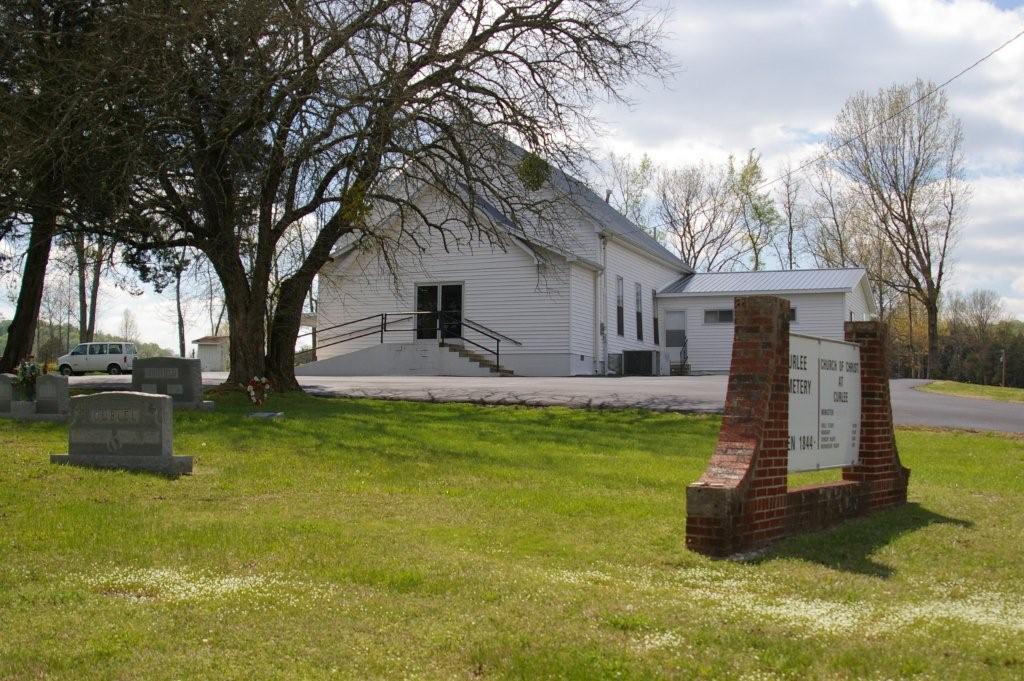
Curlee Church of Christ / Curlee Cemetery
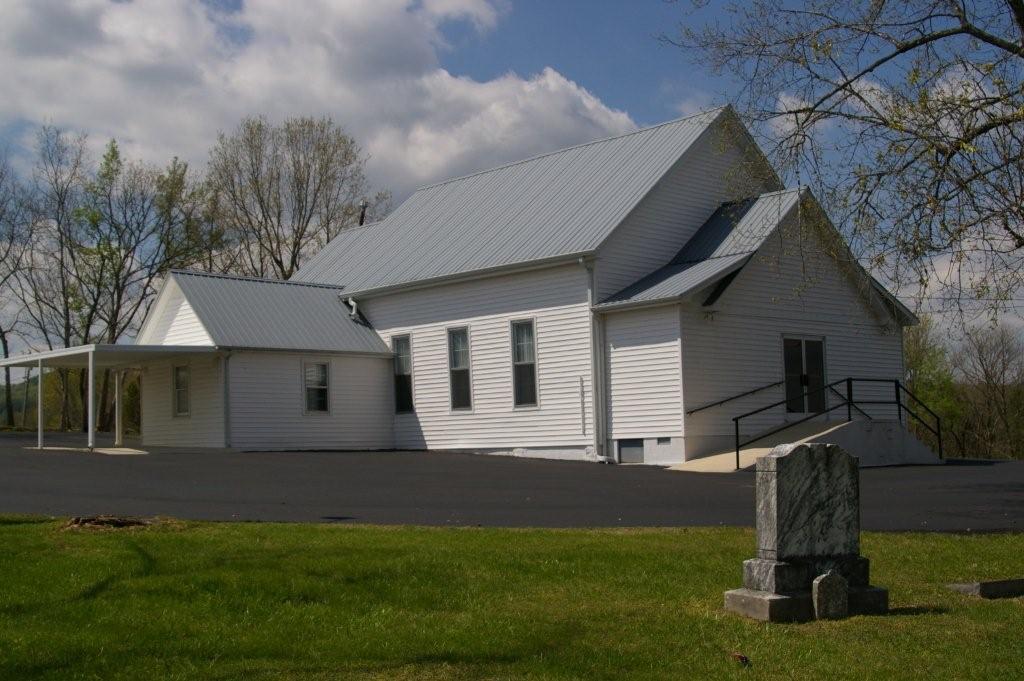
Church of Christ At Curlee
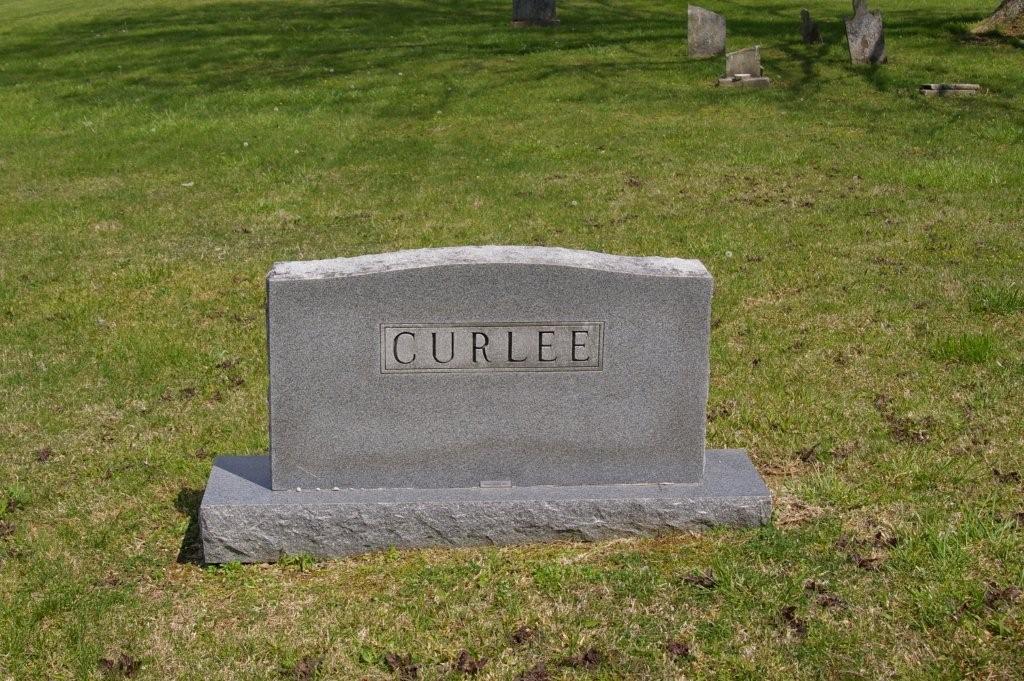
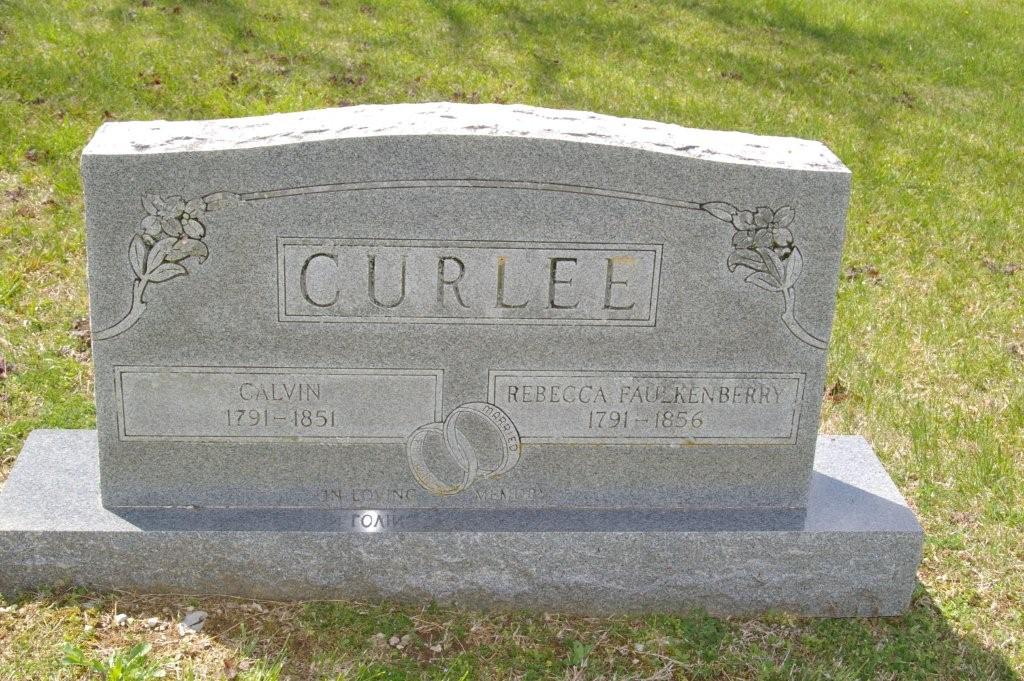
Curlee
Calvin 1791-1851
Rebecca Faulkenberry 1791-1856
In Loving Memory
C.E. Curlee, Son Of Calvin Curlee
Gospel Preacher In Central Tennessee
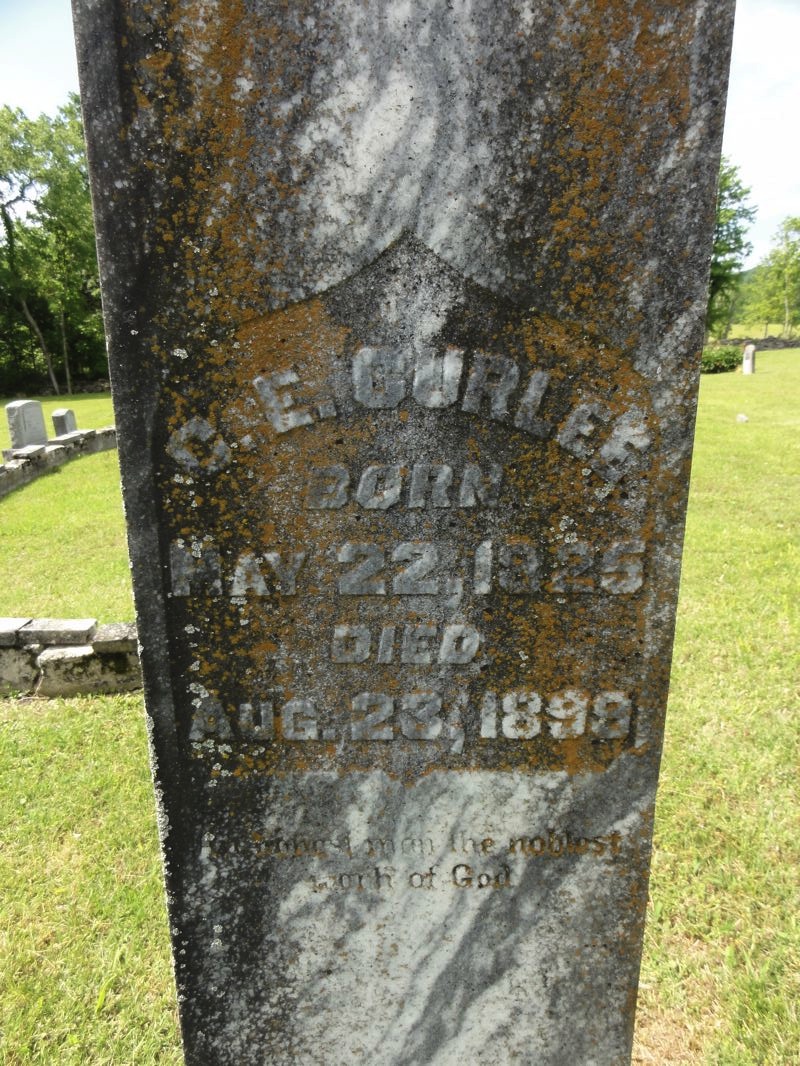
C.E. Curlee
Born
May 22, 1825
Died
Aug. 23, 1899
????? man the noblest
work of God
Grandson of Calvin Curlee: Dr. J.P. Curlee
Gospel Preacher In Middle Tennessee
Dr. J.P. Curlee In Foreground on Right. His Grandfather In Distance Near Cemetery Sign
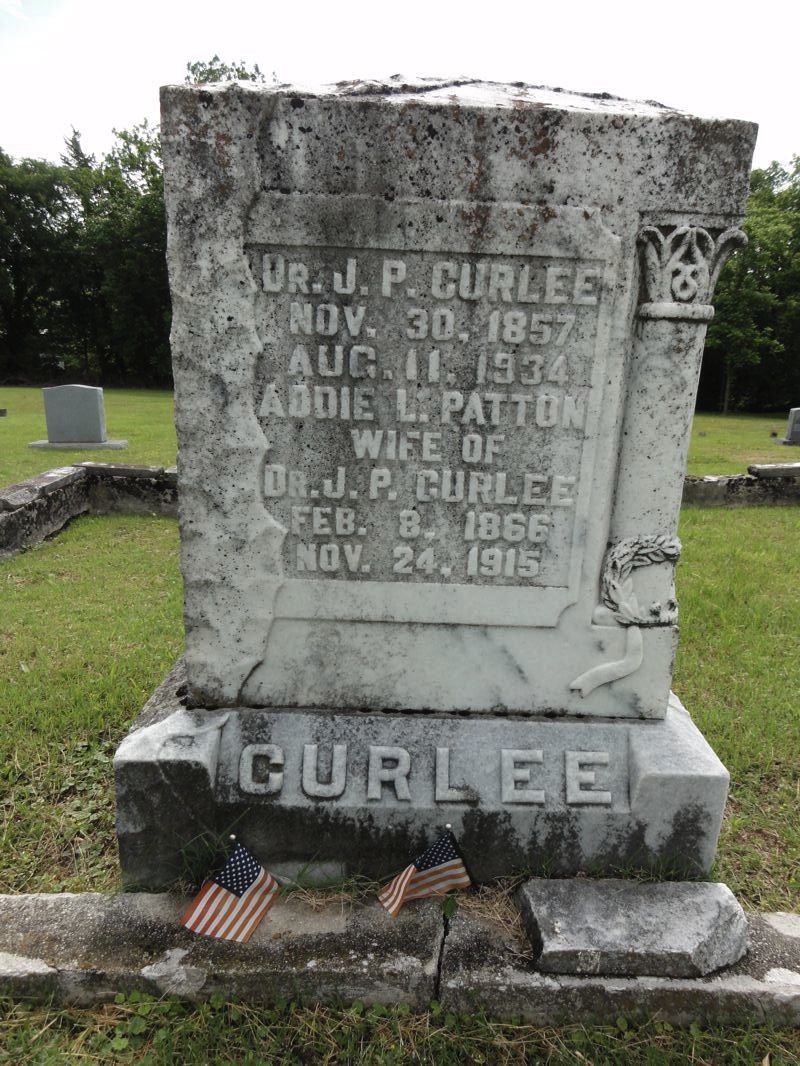
Dr. J.P. Curlee
November 30, 1857
August 11, 1934
Addie L. Patton
Wife of
Dr. J.P. Curlee
February 8, 1866
November 24, 1915
![]()
Special Thanks to Wayne Kilpatrick for the pictures of the Calvin Curlee Cemetery and Church Building pictures. Kilpatrick is a long-time friend and my former Professor of History at Heritage Christian University in Florence, Alabama. He took these photos in the Spring of 2008. The pictures of Dr. J.P. Curlee were taken by your web editor on a visit to the cemetery with Tom L. Childers and Wayne Kilpatrick in May, 2011.
![]()

